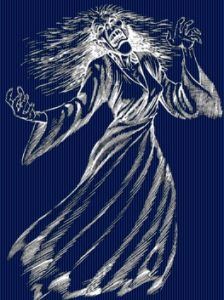By Charles M. Skinner
“Hell, with the fires out,” is what the Bad Lands of Dakota has been called. The fearless Western nomenclature fits the place. It is an ancient sea bottom, with its clay strata worn by frost and flooding into forms like pagodas, pyramids, and terraced cities. Labyrinthine canons wind among these fantastic, brilliant peaks but bleak, savage, and oppressive. Game courses over the castellated hills, rattlesnakes bask at the crater’s edge above burning coal seams, and wild men have made a despairing stand against advancing civilization. It may have been the white victim of a red man’s jealousy that haunts the region of the butte called “Watch Dog,” or it may have been an Indian woman who was killed there, but there is a banshee in the desert whose cries have chilled the blood that would not have cooled at the sight of a bear or panther.
By moonlight, when the scenery is most suggestive and unearthly, and the noises of wolves and owls inspire uneasy feelings, the ghost is seen on a hill a mile south of the Watch Dog, her hair blowing, her arms tossing in strange gestures.
If war parties, emigrants, cowboys, hunters, any who for good or ill are going through this country, pass the haunted butte at night, the rocks are lighted with phosphor flashes, and the banshee sweeps upon them. As if wishing to speak, or as if waiting a question that it has occurred to none to ask, she stands beside them in an attitude of appeal, but if asked what she wants, she flings her arms aloft and with a shriek that echoes through the blasted gulches for a mile she disappears. An instant later, she is seen wringing her hands on her hilltop. Cattle will not graze near the haunted butte, and the cowboys will keep aloof from it, for the word has never been spoken that will solve the region’s mystery or quiet the unhappy banshee.
The creature has a companion, sometimes, in an unfleshed skeleton that trudges about the ash and clay and haunts the camps in a search for music. If he hears it, he will sit outside the door and nod in time to it, while a violin left within his reach is eagerly seized and will be played for half the night. The music is wondrous: now as soft as the stir of wind in the sage, anon as harsh as a wolf’s cry or startling as a rattler’s stir. As the east begins to brighten, the music grows fainter, and when it is fairly light, it has ceased altogether. But he who listens to it must on no account follow the player if the skeleton moves away, for not only will it lead him into rocky pitfalls, whence escape is hopeless, but when there, the music will intoxicate, madden, and will finally charm his soul from his body.
Compiled and edited by Kathy Alexander/Legends of America, updated April 2024.
About the Author: Charles M. Skinner (1852-1907) authored the complete nine-volume set of Myths and Legends of Our Own Land in 1896. This tale is excerpted from these excellent works, which are now in the public domain.
Also See:
Legends, Ghosts, Myths & Mysteries
Legends, Myths & Campfire Tales of the American West
Legends, Myths & Tales of the Native Americans

